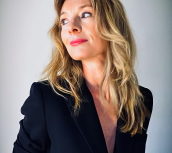
AGNES MANDEVILLE
Director Concepts Starbucks
Passionate and international architect / designer with 20 years of success creating high-profile store experiences, ranging from pop-up stores to flagships throughout Europe and North America.
Graduated from the Bordeaux School of Architecture in France, Agnes moved to the Netherlands working with Dutch renowned architectural agencies in Rotterdam and Amsterdam. She contributed to a multitude of winning competitions for public buildings and residential developments. Her career took a turn in 2010 when she joined the Starbucks Coffee Company Design team. First designing the new cafes in various European markets, she moved to the United States in 2016 to create and innovate the Starbucks store experience. Her work celebrates the idea of people, context, comfort, community and sustainability, introducing new ideas of service and interaction with the brand. Her positive contribution brought her to join as Director Concepts with the Global Growth and Concepts team in 2019 where she currently works on Brand Design strategies and the translation of those strategies to innovative multi-sensorial design concepts.
Next to her day-to-day, fueled by her creative curiosity and her poetic approach to design, she participated in workshops across multiple disciplines from City planning for Almere Haven to furniture design brainstorm for Minotti at Milano Design week. Equally enthusiastic about sharing the power of design, she has been a guest lecturer at the Delft University of Architecture and is a huge proponent of working with young talents from various design disciplines.
Agnes is a true global citizen who calls Amsterdam, Paris and Los Angeles home. If not discovering new cities, architects or stores, she prefers to enjoy the Moroccan desert as a retreat from the metropolitan life she is exposed to day to day.
What did you most enjoy about the IDA judging process?
It’s great to be able to see so many projects coming from so many regions, cultures and parts of the world. Themes and societal questions might be the same everywhere – especially now, however retaining richness in designs and cultural aesthetics is truly fundamental for me. In other words, as a jury member, it was important to place myself in the context of each project, its origin and its narratives in order to appreciate all of the qualities of each design.
How did you feel about the quality of the students’ entries?
There were lots of great projects by students. A few definitely really stood out from the rest for me. Amongst those there was a remarkable intellectual and aesthetic cohesion and a layered poetic approach too.
After reviewing the IDA projects, did you see evidence of current trends or challenges in the design industry?
TGenerally being very aware of ‘inspired by’ versus ‘copy’. We all see the same images and use the same platforms for inspirations. It’s very real. It’s not wrong to base your designs on something you like, the right thing is asking yourself why you like it and what does it answer… And from there to continue on your own personal creative path.
What advice would you give to future entrants?
Visual clarity and sharp storytelling. We are all inclined to see an ‘image’ first and it must instantly tell the story. In some way the text is supportive but doesn’t replace the intuitiveness of a strong, immediate appealing visual.
What do you think are the biggest challenges and opportunities in your career/industry now?
Staying relevant and agile. Keep working on innovations despite contemporary challenges we are all facing. Allow design to be a positive link between people. As a designer: it’s important to stay critical and true to one’s self. Fight ‘sameness,’ easiness and also embrace diversities, more inclusivity in one’s works. Promote Optimism through projects.